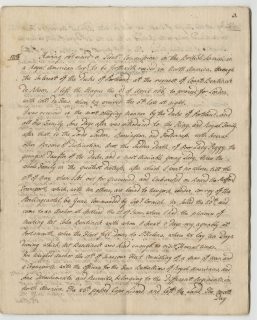
Lt. Rudolph Bentinck’s thirty-page journal of his service in the French and Indian War begins in April 1756, when, “Having obtained a Lieuts Commission in the British service, in a Royal American Regiment, to be forthwith raised in North America,” he left his home in the Hague to assume his new duties.
The brutality of warfare in the North American wilderness during the French and Indian War comes through vividly in a British army officer’s manuscript journal acquired by the Institute in February 2020. Its author, Rudolph Bentinck (1738-1820), was a Dutch-born lieutenant in the Royal American Regiment, a special infantry unit raised to meet the challenges of frontier combat. In September 1758, as part of Gen. John Forbes’ expedition to drive the French out of the Ohio River Valley, he volunteered to serve on a reconnaissance mission led by Maj. James Grant to assess enemy strength at and around Fort Duquesne, the French-held stronghold at the confluence of the Allegheny and Monongahela rivers. As approximately four hundred troops under Grant advanced, Bentinck wrote, “1500 French and Indians sallied out upon us, with a Horrid Howling, like a wild Beast.” Lining up in traditional military formation “to receive the enemy, whom we could not yet see through the thickness of the underwood,” the British force opened fire at first sighting, seeming to repel them back into the woods, he wrote, “but instead of that, they crept on all fours, till they had almost surrounded us, when all at once, we received a very hot fire, without seeing the Enemy, and within a few minutes, all the officers, and above half the men were killed or wounded, upon which the remainder retreated in the greatest confusion.” It was a hard-learned lesson for the British troops, who, Bentinck noted, were “not much acquainted with the Indian way of fighting, and too brave to sculk behind trees.”
The British and American forces suffered 342 casualties in the battle, including Major Grant, who was taken prisoner. Lieutenant Bentinck was only one of two officers of the Royal American Regiment on the mission who survived. The French continued to hold Fort Duquesne, though with reduced numbers and cut off from supplies.
Closely following the events was twenty-six-year-old Col. George Washington, commander of the Virginia provincial troops, who lost six officers in Grant’s failed mission and knew well the perils of the Ohio Country from his earlier experience with the Braddock expedition. In November, with winter approaching, General Forbes initiated one more attack on the fort. Lieutenant Bentinck noted in his journal that “2,400 men are to be picked, to march in 3 divisions under the command of Colonels Bouquet, Mongommery [Archibald Montgommerie] and Washington, to act as Brigadiers.” (Washington was the only provincial officer to be honored with that position during the war.) Washington brought the totality of his frontier experience to the planning of this third attempt to capture Fort Duquesne, but as the three divisions moved into position, they discovered that the remnants of the French garrison had set fire to the fort and abandoned the site on November 26. Two weeks later, Bentinck recorded, “General Forbes gave an order that for the future Fort du Quesne should be called Fort Pitt,” in honor of British prime minister William Pitt, who had ordered its capture.

Lt. Rudolph Bentinck listed Col. George Washington, commander of the Virginia provincial troops, as one of the three brigadiers appointed to lead the assault on Fort Duquesne in November 1758.
The descriptions of the momentous events around Fort Duquesne in the fall of 1758 comprise seven pages of Lt. Rudolph Bentinck’s thirty-page journal, which had been previously unknown to scholars of the French and Indian War. Bentinck’s narrative begins in Holland in 1756, when he received his commission in the Royal American Regiment. He traveled from the Hague to London, and then set sail for America on May 17. Landing in New York, he was appointed to serve under Col. Henry Bouquet, who would become his military mentor.
Bentinck documented with remarkable detail how men were assigned to the four battalions of the Royal American Regiment (noting the exceptions made to the rules), providing the rates of pay for officers and soldiers of various ranks. He spent his first winter in Philadelphia, writing candidly about the manners and social customs of the Americans he encountered. In 1757, he was sent to Charleston, South Carolina, to recruit troops, noting that an outbreak of smallpox on the English fleet sent the local residents into a panic when the ships arrived. He wrote critically of the actions of several senior officers, and he revealed his own disappointment and jealousy when a younger officer received a promotion over him “in consideration of having a little money.” He recorded the news of the war in other theaters, making note of the death of Gen. James Wolfe on the Plains of Abraham on September 13, 1759, in the decisive battle that won Canada for Great Britain. The journal ends with Bentinck’s departure from New York for England in July 1762.
Bentinck’s French and Indian War journal is a landmark acquisition for the Robert Charles Lawrence Fergusson Collection, which specializes in the theory and practice of warfare the eighteenth century. It will be available to scholars in the Institute’s library, and plans are being made to have it digitized so that its rich content will be available to a wide audience.
View the Manuscript